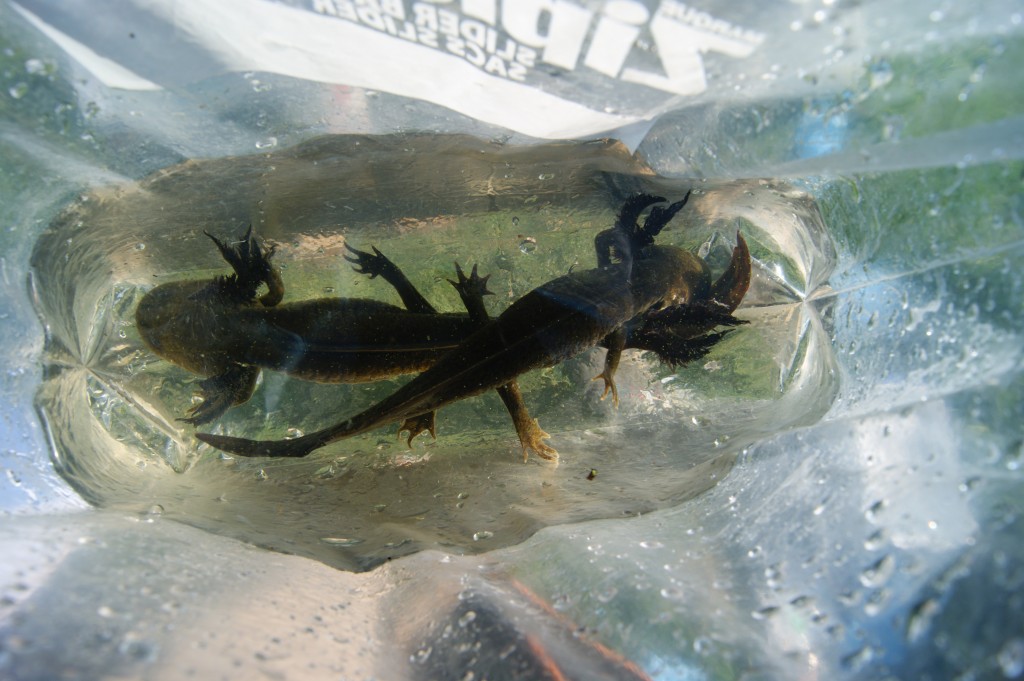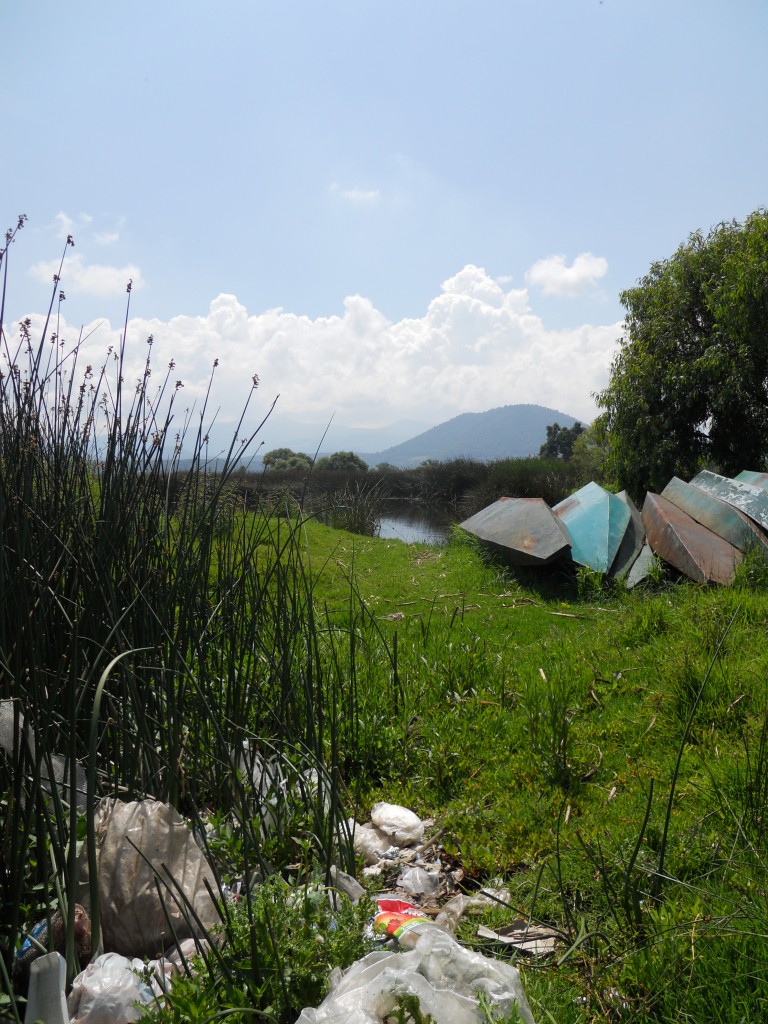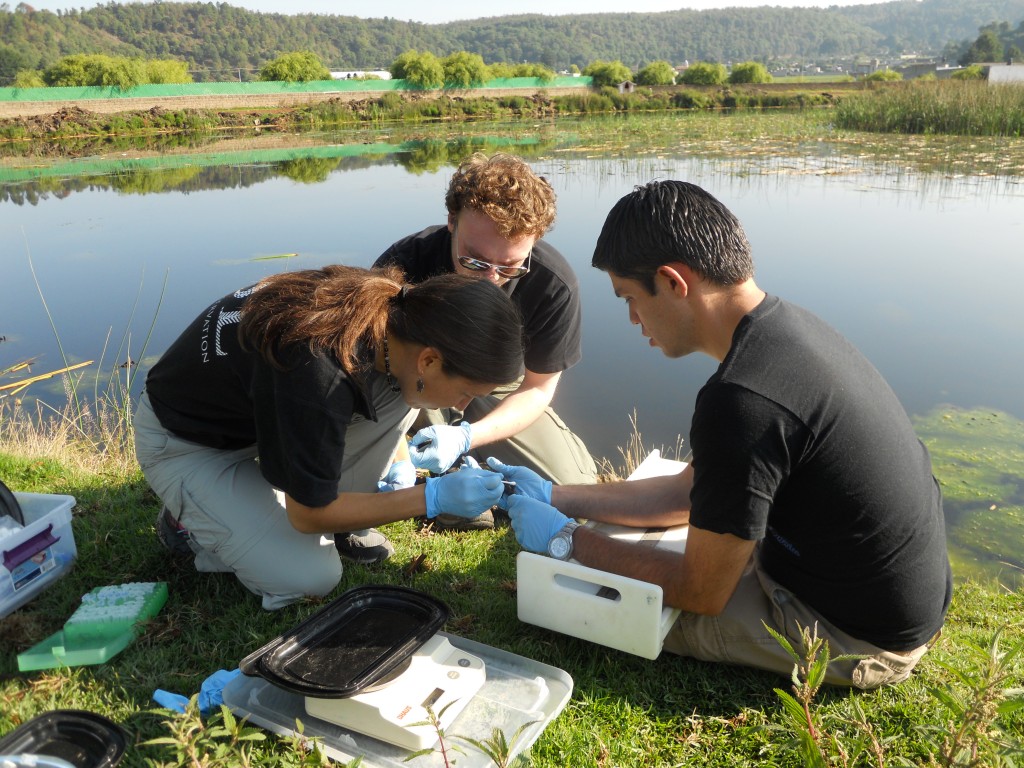
I am standing on a narrow isthmus of land, essentially a dirt track running on top of a levee. On my right is a fragment of the once vast Lerma wetland, one of the last sites for the Lerma Salamander (Ambystoma lermaense), joint number 7 EDGE Amphibian species. Salamanders rise up to the surface in lazy arcs, gulping air from the surface of the turbid water. However, the reed beds around the dark pools are choked with litter and the water’s surface is slick with a patchy, livid green scum. The reason is apparent on turning to my left. A dark, foetid channel runs thickly in a ditch perhaps two meters wide. The stench of the region’s industrial and domestic effluent hangs in the hot air as the ooze makes its way past the wetland toward the Lerma river, the most polluted in the world.
“There’s nothing living in there!” says EDGE Fellow Dr. Karla Pelz Serrano, who is working to conserve the Lerma salamander.
“Except bacteria…” says Dr. Rurik List Sanchez, Karla’s boss at Mexico City’s Universidad Autónoma Metropolitana, dryly. The dark waters of the sewage canal overflow into the ‘protected’ wetland where the Lerma salamanders live after heavy summer rains, Karla explains. The water in the wetland was clear 6 months ago, now it is a muddy brown colour. Pollution is a major issue at most of the remaining sites for this species on the outskirts of Mexico City, alongside unsustainable water extraction, the introduction of carp and trout, which eat juvenile salamanders, the dumping of refuse and the removal of natural vegetation. This rather depressing sight is the beginning of my site visit to the two current EDGE Fellows working on amphibians in Mexico.

Karla is about to conclude her two year EDGE Fellowship and with us is Jose Alfredo Hernandez Diaz, known to everyone as Alfredo. He is the Curator of Reptiles and Amphibians at Africam Safari Zoo in Puebla, and is just beginning his Fellowship on another Mexican salamander, the Alchichica or Taylor’s salamander (Ambystoma taylori). Mexico is an important region for the diversity of Ambystoma or mole salamanders. Seventeen species are found within its borders, eight of which are critically endangered and two of which are listed as endangered by the IUCN. Many of these species exhibit a phenomenon known as ‘neoteny’ or ‘paedomorphosis’, whereby animals (sometimes as a matter of course, sometimes depending on the environment) circumvent the normal life cycle of amphibians and become reproductively mature in the tadpole phase, with large branching gills and other larval characteristics. Ambystoma mexicanum is the best known of these so-called ‘Peter Pan’ salamanders, and the Mexican term axolotl, in Europe usually referring to this species, in fact refers to any neotenic Ambystoma.
The state of affairs at Lerma in many ways reflects the immense pressure that biodiversity is under across Mexico. The country is undergoing rapid development and accompanied environmental degradation, with habitat disappearing under city and farmland at an alarming rate. For this reason, it is critical that conservation capacity is generated quickly in Mexico and that individuals working to stem the tide have the opportunity and training to work together. This is exactly the goal of the EDGE programme, and in Mexico the number of current and past EDGE Fellows is quietly growing to form a conservation network supported by ZSL. For the moment the focus is on Mexico’s mole salamanders and the strengths of the programme are already beginning to show.
Karla has taken a double-pronged approach to conserving the Lerma salamander, combining scientific research with community engagement. Almost nothing is known about the salamander, its biology and its conservation needs and Karla’s field surveys have begun to establish exactly where the salamander can still be found, how many are left and which populations are still viable, as well as the extent of threats to their survival. At the same time, by working with local communities, she has raised awareness and provided a means for communities to tackle the governmental corruption that is failing to protect their wetlands.
While at Lerma, we visit several of the remaining populations (one of which was previously unknown) and set traps for the salamander to extend Karla’s survey data. We capture some animals and I train both Karla and Alfredo in Visible Implant Elastomer (VIE) marking, whereby a small quantity of fluorescent polymer is injected under the skin in order to identify individual salamanders. By doing this, Karla can estimate population sizes in order to understand how many salamanders are left in the wild and whether this number is changing. She can also use marking to cast some light on how long axolotls live, how far they move and where they go in their habitat. More importantly, Alfredo takes the opportunity to learn from Karla’s almost two years’ of EDGE experience. Karla demonstrates how to swab the salamanders to collect their DNA and to check for pathogens, as well as how to measure the animals’ vital statistics. With this information, Karla can monitor age and size structure in the population, general health status, and growth rates. With the genetic data she can work out if populations are genetically isolated from one another, and how healthy their gene pools are.
I leave Lerma with a sense of the huge scale of the conservation task at hand but also hope in the knowledge that Karla is now using her leadership and determination to become the champion that the salamander and its wetlands desperately need and have until now lacked.
